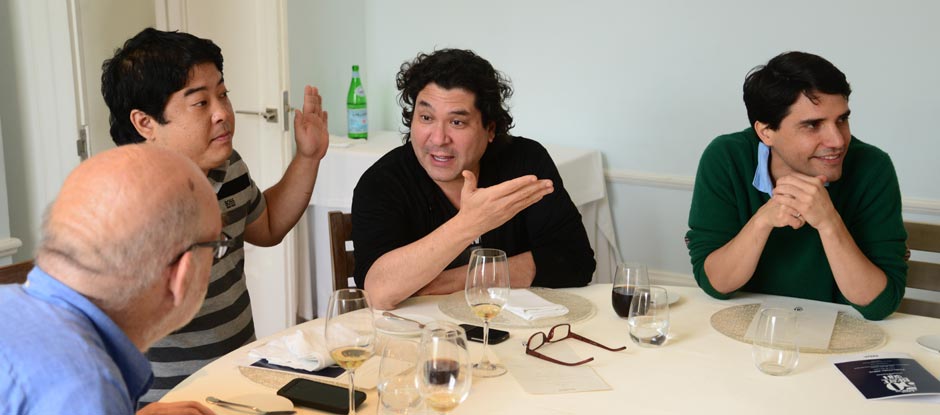Peruvian food has burst onto the global stage in the last few years with its colourful ceviche, vibrant restaurant scene and seemingly endless supply of superfoods championed by celebrities and supermodels alike. While this sudden global recognition may seem like a triumph for a nation that has long been proud of its rich and varied cuisine, it also brings questions and challenges for the country’s cooks, farmers and producers.
At the second #50BestTalks event held in Lima, our panel of chefs, restaurateurs and food journalists discussed key issues surrounding Peru’s gastronomic identity: is the current state of the restaurant industry sustainable? Is Peruvian fine dining accessible only to the rich and if so, what is the role of high-end and avant-garde cooking? Finally, how can the chefs in the spotlight help revive lost traditions and give the world access to the full spectrum of Peruvian cuisine?
Tweet #50BestTalks
One of the key issues raised by our panel was the role of avant-garde. While Peru’s gastronomic elite has grown in leaps and bounds in recent years, the small handful of restaurants it represents is mostly frequented by tourists, and the country’s lack of economic development and a solid middle class mean there is little support for newcomers. Nevertheless, Gastón Acurio, owner of Astrid y Gastón, said that innovative forms of cooking are vital because they help the country stand out.
“It’s very important for Peruvian cuisine that avant-garde exists,” said Acurio. “There’s an avant-garde that means creativity, which is very important in terms of added value for any country.”
#50BestTalks #BBVA @gaston_acurio: desde un punto estratégico es importante que en el Perú exista una vanguardia, con restaurantes creativos
— Latin America's 50 (@LatinAmericas50) November 27, 2014
Diego Salazar, Academy Chair for the northern part of South America and multi-platform editor of Perú21, added that although most of Peru’s avant-garde restaurants aren’t accessible to the masses, they provide an important reference for other restaurants and help set standards. Experimental cooking is also a great way to explore the country’s rich natural resources, according to Franco Kisic of IK Restaurante.
Luciana Olivares, publicity manager at BBVA, which sponsored the event, said innovative cooking styles also help the country as a brand: “We need avant-garde for internal and external positioning. It’s very important because it gives you that differentiation, makes you feel special. The idea is to maintain that and cultivate it – to reinvent.”
Mitsuhara Tsumura, chef-owner of Maido in Lima, added that avant-garde means something different to Peruvians than to foreign visitors, who may view a classic local ceviche as something exotic and different. Since two-thirds of the customers at Virgilio Martínez’s restaurant Central are tourists, it seems an important distinction. But are those foreigners going home with a one-sided view of Peruvian cuisine?
“Our cuisine is fantastic, but the rest of the world sees only ceviche and tiraditos,” said Ignacio Medina, a Spanish food writer who has lived in Peru for almost a decade. “We’ve created a false reality – the great Peruvian cuisine. We’re the best in the world, we work with four or five dishes, but where’s the rest of our cuisine? Where is Lima’s cuisine? Where is Arequipa’s cuisine? Where is that of Puno?”
While Peru’s food industry may have become Lima-centric and certain traditions abandoned, Medina believes it’s the industry professionals who have a responsibility to make the changes. “There’s a cuisine that has grown and there’s one that’s been left behind. Our society is ashamed of the food trucks – nobody wants to buy from the food trucks when they reach a certain socio-economic level because that’s for poor people,” he said. “The first thing we need to do is work, become critics, learn to have our own dishes. We’re the ones who influence our cuisine. We’re the ones who must set the trends and priorities.”
#50BestTalks #BBVA Desde la cocina de Astrid&Gastón Casa Moreyra pic.twitter.com/V05mj3Xqkr
— Latin America's 50 (@LatinAmericas50) November 27, 2014
Renato Peralta, owner of Eggo Bread & Breakfast in Lima, said it’s the specialist and international restaurants that will really allow the country’s cuisine to thrive. “Lima will improve as a gastronomic capital when we start seeing other types of restaurants, those that are specialising in something, like the new restaurants in Barranco [a trendy bohemian neighbourhood]. We need haute cuisine because without it, Peru won’t become known, but it also has to become known for what it offers people – not just five avant-garde restaurants but also somewhere where you can have a great coffee.”
There’s also an opportunity for Peru’s chefs and restaurateurs to learn from the influx of foreigners who are bringing their own traditions and techniques to the country, according to Renzo Garibaldi, owner of Osso. “Peru is in a moment where loads of people are coming from abroad to work,” he said. “These people are coming not only to learn but also to teach, and that exchange of information helps us to keep growing and learning. If we just stick with what we’ve got in Peru and don’t absorb the bits that come from overseas, there will come a time when we’ll dry up.”
If you missed the #50BestTalks livetweet, you can catch up on all the posts here: https://t.co/orzlz0CZDb #Peru #gastronomy
— The World's 50 Best (@TheWorlds50Best) November 27, 2014
Would you like to be involved in the next #50BestTalks event in Buenos Aires, Mexico City, Singapore or São Paulo? We'll be inviting questions for our top panels of chefs and restaurateurs – to be announced in the New Year – on Twitter, Facebook, Instagram and Google+. You can join in the live chat and also propose topics for our panel
You can also buy tickets to the events programme at Asia's 50 Best Restaurants, including the Singapore Summit and Masterclasses featuring Gastón Acurio, Virgilio Martínez, Hector Solís & Mitsuharu Tsumura
With thanks to BBVA, Official Banking Sponsor of Latin America's 50 Best Restaurants

